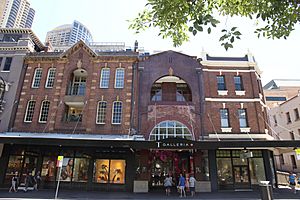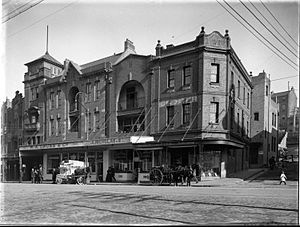149-151 George Street, The Rocks facts for kids
Quick facts for kids 149–151 George Street, The Rocks |
|
|---|---|

149-151 George Street is located on the left, pictured in 2019.
|
|
| Location | 149–151 George Street, The Rocks, City of Sydney, New South Wales, Australia |
| Built | 1913 |
| Owner | Property NSW |
| Official name: Shops and Residences; Currently part of Duty Free Store complex | |
| Type | State heritage (built) |
| Designated | 10 May 2002 |
| Reference no. | 1594 |
| Type | historic site |
| Lua error in Module:Location_map at line 420: attempt to index field 'wikibase' (a nil value). | |
The building at 149–151 George Street, The Rocks is a special historic place in Sydney, Australia. It's located in an old area called The Rocks. This building was first built in 1913.
Today, it's part of a bigger shopping complex called the Duty Free Store. It used to be a shop and homes. The government of New South Wales owns this property. Because of its history, it was added to the New South Wales State Heritage Register in 2002. This means it's protected and important to keep for the future.
Contents
A Look Back in Time
This area has a long history, going back to the early days of European settlement in Australia. In 1807, two important people, Surgeon General John White and Captain William Raven, had land here.
Around 1835, a Mrs. Underwood owned and possibly built some stone shops and houses. Later, in 1845, a two-storey brick house and shop were built. There was also a stone and brick house and store nearby.
In 1861, one of these buildings became a "Bowling Alley." Later, in 1871, a pub called the "Nil Desperandum Hotel" opened at what is now 155 George Street.
By 1882, three new two-storey buildings were put up next to the hotel, which was then called the New York Hotel. These were shops and homes made of brick.
In 1900, after a serious sickness called the bubonic plague, the government took over all the land in The Rocks area. The New York Hotel was pulled down in 1907. A new New York Hotel was built nearby in 1908 by a company called Tooth & Co..
The building we see today at 149 and 151 George Street replaced older buildings in 1911. It became known as the "Quay Chambers."
A butcher company, W. A. Grubb, was a very long-term tenant here. They moved into 149–151 George Street in 1912 and stayed until the 1980s.
In 1986, big plans were made to develop this whole area. This included building a ten-storey office block and making changes to the shops facing George Street. Number 147 George Street became an entrance for the Duty Free Store. More changes happened in 1998 to the Duty Free Store, including updating the shop fronts.
What the Building Looks Like
The building at 149–151 George Street was built in 1913. It's a three-storey building made of brick. It has features typical of the Federation period, which was an architectural style popular around the early 1900s.
You can see special details like sandstone bands and keystones (wedge-shaped stones at the top of arches). It also has a gabled parapet, which is a low wall at the edge of the roof.
Other cool features include a stone cornice (a decorative molding) and fancy metalwork on the drainpipes and awning supports. The building has a double-level balcony opening, similar to the building next door at 147 George Street.
W. A. Grubb & Co. butchers were the first businesses here. The shop front has changed over the years. For example, a central door was turned into a window. The original awning, which had a special pressed metal lining, was removed in the 1980s.
Changes Over Time
- In 1988, the building became part of the DFS complex. The back of the building was removed, and new shop fronts were created.
- The area around the building also changed a lot. In 1946, the Public Transport Commission bought this site. The City Circle Railway, which runs underground, opened in 1956.
- In the late 1980s, a large commercial building was built behind 145–155 George Street. The front parts (or façades) of the old buildings were updated.
Why This Place is Special
The building at 149–151 George Street is very important for its history and design. It's part of a group of four buildings that stand together on George Street. This group helps show what The Rocks area looked like in the past.
This building is important because:
- It's on a site that has been used by Europeans since 1788, making it one of the oldest settled spots in Australia.
- It shows how The Rocks area changed over the 20th century. This includes changes after the 1900 plague, big transport projects like the Cahill Expressway and the city railway, and how The Rocks became a tourist spot in the 1980s.
- It's part of a group of buildings that give George Street a special look. They are made of brick and stucco and fit well together.
- The building itself shows the commercial architecture from the early 1900s. It also reminds us of businesses like W. A. Grubb butchers.
The fight to save The Rocks area was very important to the local community. People in Sydney and New South Wales care a lot about The Rocks as a heritage area. It's a popular place for tourists because of its history.
This building and the shops around it show how the area's business changed from supporting the port to focusing on tourism.
Unique Features
149–151 George Street is quite unique because of its central arch design. This arch is highlighted by the double-height balcony spaces. The way the brickwork is combined with sandstone details and a special gable design makes the building stand out.


